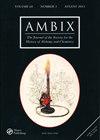A Nobel Affair: The Correspondence Between Alfred Nobel and Sofie Hess
IF 0.3
3区 哲学
Q3 HISTORY & PHILOSOPHY OF SCIENCE
引用次数: 0
Abstract
There is noNobel prize inMathematics, the urban legend goes, because a mathematician was the lover of Madame Nobel. But then most people know Alfred Nobel remained a bachelor until his death in 1896. What is less known is that there are envelopes addressed to a Madame Nobel in Alfred Nobel’s own writing. He maintained a long-term affair with a young Austrian woman, Sofie Hess. The affair between the forty-three-year-old wealthy vagabond of Europe and the twenty-six-year-old flower shop girl started in 1876 with all the traditional trimmings – endearing pet names, luxury gifts, meetings on Nobel’s business travels, and different apartments and places for Hess to stay, in Paris and elsewhere. Their epistolary exchanges continued long after their relationship had progressively soured, yielding a significant body of correspondence. The letters were deliberately kept hidden by those in charge of Nobel’s legacy and his first biographers, and when Hess threatened to sell the letters of her deceased lover, despite a significant sum left to her in Nobel’s will and her previous promise to destroy those letters, the lot was swiftly acquired by the Nobel Foundation to make sure this part of his life would remain in the shadows. They were not destroyed, though, and this is fortunate, even if scholars had to wait until 1976 to access this archive. For those curious about the love life of great men, Alfred Nobel’s case is rather disappointing. Apart from his mother, there are only two female figures who stand out: Bertha von Suttner and Sofie Hess. And with these two, it would be difficult to find more contrasting characters: one of noble descent, highly educated, mastering several foreign languages, politically engaged, and aiming to improve society; the other from the lower bourgeoisie, struggling to write in her own mother tongue, oblivious to the issues of her day, and unfocused even in her aim of being a high-maintenance kept woman, requesting large amounts of money, but not seizing opportunities for social or intellectual advancement through her benefactor’s tutelage. Von Suttner inspired Nobel’s idea for the Peace prize, while Hess seems to have passed through his life without leaving much of a trace. Yet Nobel corresponded with both, offering glimpses into hugely different aspects of his personality, and the image of himself he wanted to project. On that point, A Nobel Affair provides more insight into Nobel’s psychological and social difficulties than Edelgard Biedermann’s German edition of his correspondence with von Suttner. Because he plays less of a role on an imaginary stage when he writes to Sofie, Alfred appears more crippled in his anxiety and paranoia about his business and health, uncertain about his big projects and the path to take, often depressed, gradually more misanthropic, and definitely less of a gentleman and benefactor of humankind in his treatment of what he identifies as his lover’s deficiencies both in character and social provenance. Progressively he becomes suspicious of Sofie’s relatives, their intentions and bad influence (sometimes rightly so), patronising her thoughtless social behaviour which he found endearing at first, and showing himself quite judgmental and harsh in underlining her lack of writing style, her unrefined manners, and her greediness and profligate spending. Yet over the two decades of their exchanges, he remains devoted to her, covering her expenses and worrying for her health and whereabouts, despite her bearing the child of a man he induced her to marry in the hope that the father would care for the family. Eventually he breaks off all contact, forbidding Sofie to send any further letters following a financial arrangement set up by his lawyer.诺贝尔事件:阿尔弗雷德·诺贝尔与苏菲·赫斯的通信
坊间流传着诺贝尔数学奖的由来,因为一位数学家是诺贝尔夫人的情人。但大多数人都知道阿尔弗雷德·诺贝尔直到1896年去世都是单身。鲜为人知的是,有些信封是写给诺贝尔夫人的,是阿尔弗雷德·诺贝尔自己写的。他与一位年轻的奥地利女子苏菲·赫斯保持着长期的婚外情。这个43岁的富有的欧洲流浪汉和这个26岁的花店女孩的恋情始于1876年,伴随着所有传统的装饰——可爱的宠物名字,奢侈的礼物,诺贝尔商务旅行中的会面,以及在巴黎和其他地方为赫斯提供的不同的公寓和住所。在他们的关系逐渐恶化之后,他们的书信交流仍在继续,产生了大量的信件。这些信件被负责诺贝尔遗产的人和他的第一批传记作者故意隐藏起来,当赫斯威胁要卖掉她已故情人的信件时,尽管诺贝尔遗嘱中给她留下了一大笔钱,她之前承诺要销毁这些信件,但诺贝尔基金会迅速获得了这些信件,以确保他生命的这一部分不会被曝光。然而,它们并没有被摧毁,这是幸运的,即使学者们不得不等到1976年才能访问这些档案。对于那些对伟人的爱情生活感到好奇的人来说,阿尔弗雷德•诺贝尔(Alfred Nobel)的情况相当令人失望。除了他的母亲,只有两个女性形象引人注目:伯莎·冯·苏特纳和苏菲·赫斯。在这两个人身上,很难找到更鲜明的对比:一个是贵族血统,受过高等教育,掌握几门外语,参与政治,旨在改善社会;另一个来自下层资产阶级,挣扎着用自己的母语写作,对当时的问题浑然不觉,甚至对自己的目标也不专注,她想成为一个高赡养的女人,要求大量的钱,但却没有抓住机会,在她的恩人的监护下获得社会或智力上的进步。冯·苏特纳启发了诺贝尔设立和平奖的想法,而赫斯似乎在他的一生中没有留下多少痕迹。然而,诺贝尔与这两者都有联系,这让人们得以一窥他性格中截然不同的方面,以及他想要展现的自己的形象。在这一点上,与埃德尔加德·比德曼(Edelgard Biedermann)的德文版诺贝尔与冯·苏特纳(von Suttner)的通信相比,《诺贝尔事件》(A Nobel Affair)提供了更多关于诺贝尔心理和社会困难的见解。因为当他写信给苏菲时,他在一个虚构的舞台上扮演的角色少了,阿尔弗雷德对自己的事业和健康的焦虑和偏执显得更加残缺,对自己的大项目和未来的道路不确定,经常沮丧,逐渐变得厌恶人类,在处理他认为爱人在性格和社会出身方面的缺陷时,他显然不像一个绅士和人类的恩人。渐渐地,他开始怀疑苏菲的亲戚,他们的意图和不良影响(有时是正确的),对她轻率的社交行为不屑一顾,他起初觉得这很可爱,并在强调她缺乏写作风格、举止粗俗、贪婪和挥霍方面表现出相当的评判和严厉。然而,在他们交往的二十年里,他仍然忠于她,支付她的费用,担心她的健康和下落,尽管她生了一个男人的孩子,他劝她嫁给一个男人,希望他的父亲能照顾这个家庭。最终,他断绝了一切联系,并根据他的律师的财务安排,禁止苏菲再给他写信。
本文章由计算机程序翻译,如有差异,请以英文原文为准。
求助全文
约1分钟内获得全文
求助全文
来源期刊

Ambix
HISTORY & PHILOSOPHY OF SCIENCE-
CiteScore
0.80
自引率
60.00%
发文量
42
审稿时长
3 months
期刊介绍:
Ambix is an internationally recognised, peer-reviewed quarterly journal devoted to publishing high-quality, original research and book reviews in the intellectual, social and cultural history of alchemy and chemistry. It publishes studies, discussions, and primary sources relevant to the historical experience of all areas related to alchemy and chemistry covering all periods (ancient to modern) and geographical regions. Ambix publishes individual papers, focused thematic sections and larger special issues (either single or double and usually guest-edited). Topics covered by Ambix include, but are not limited to, interactions between alchemy and chemistry and other disciplines; chemical medicine and pharmacy; molecular sciences; practices allied to material, instrumental, institutional and visual cultures; environmental chemistry; the chemical industry; the appearance of alchemy and chemistry within popular culture; biographical and historiographical studies; and the study of issues related to gender, race, and colonial experience within the context of chemistry.
 求助内容:
求助内容: 应助结果提醒方式:
应助结果提醒方式:


